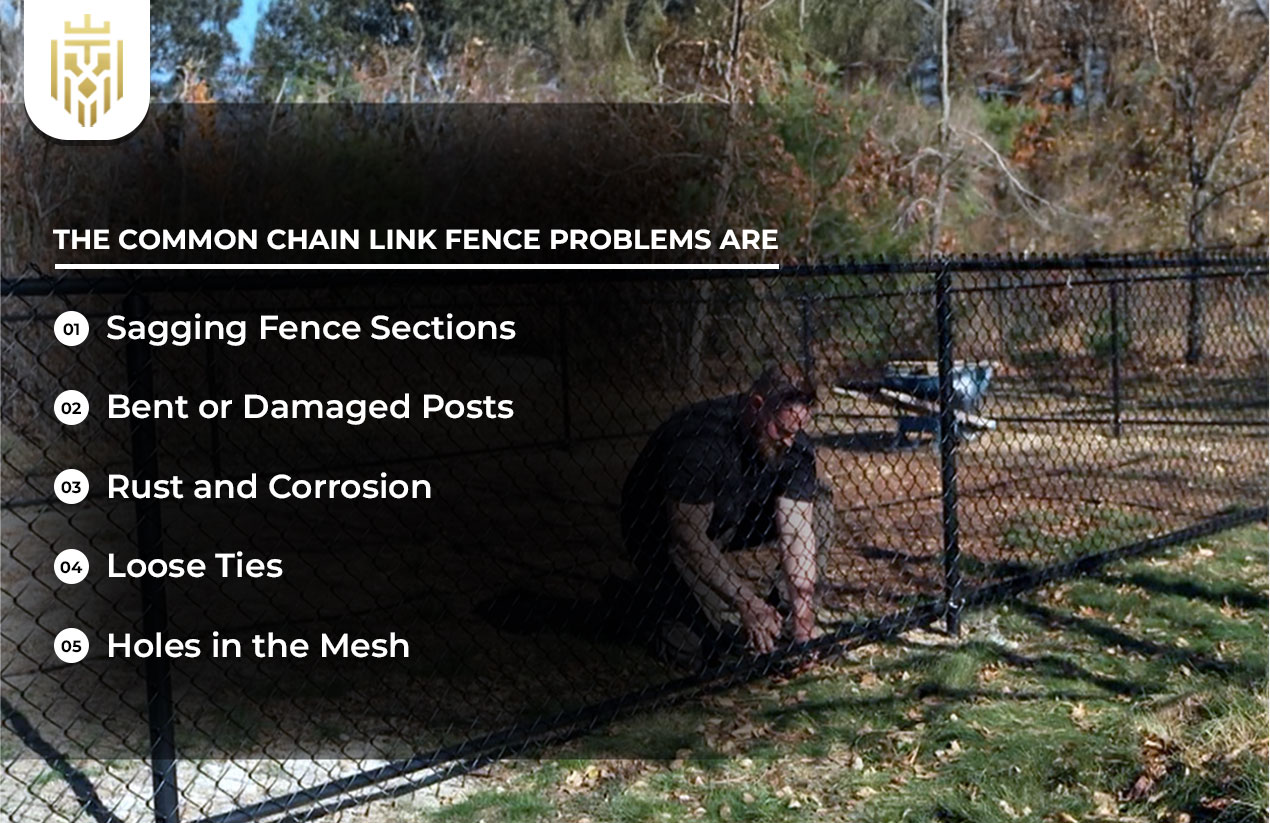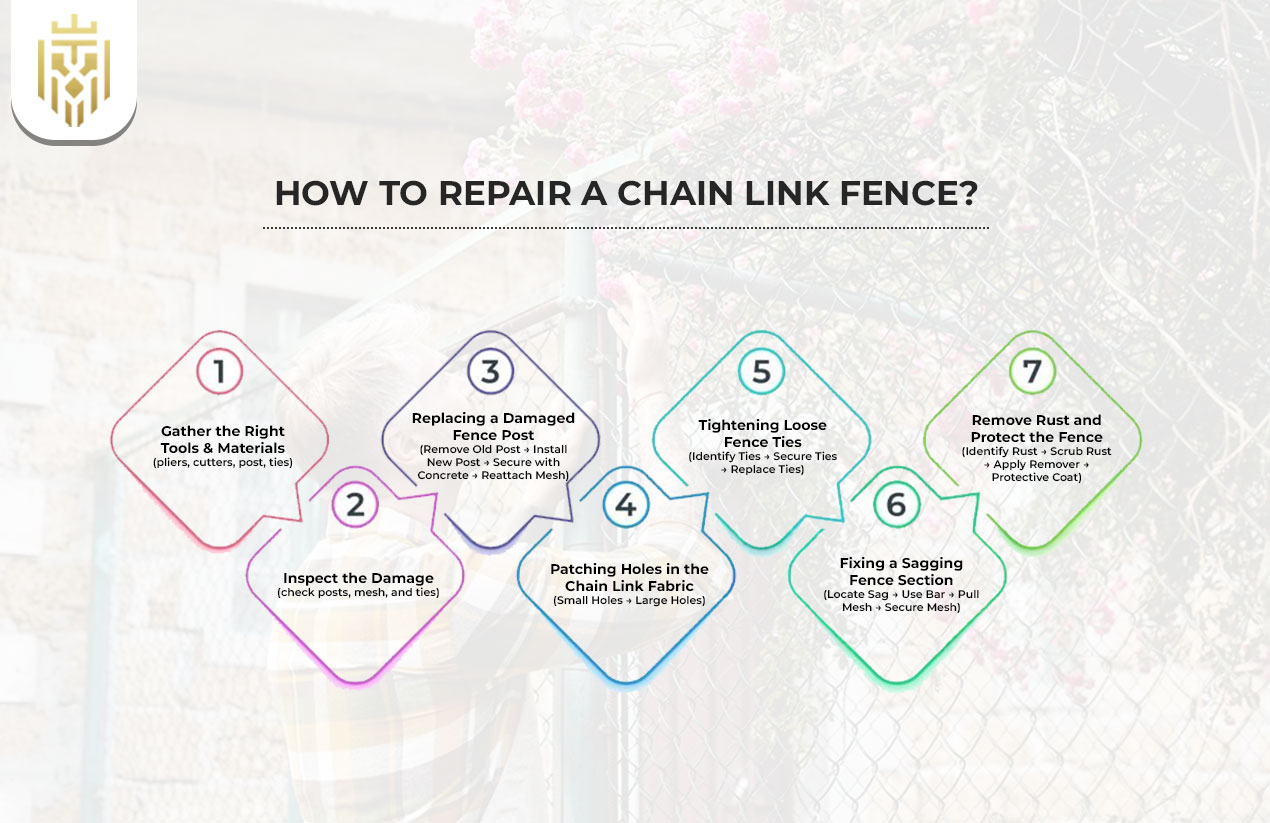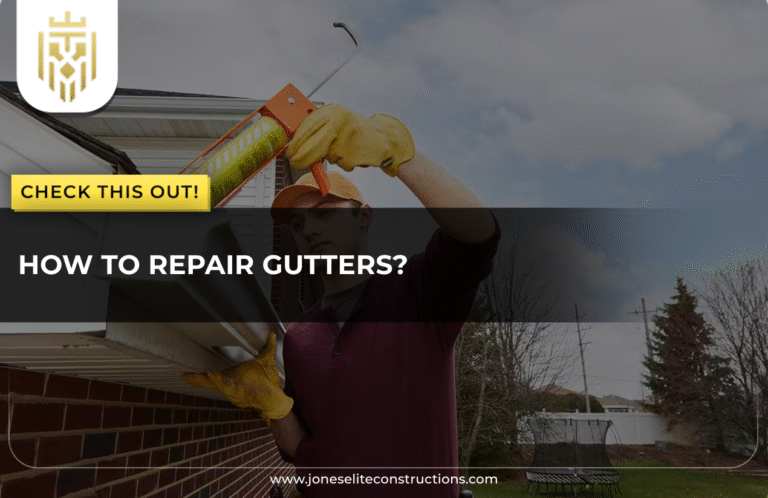How to Repair a Chain Link Fence
A chain link fence repair is crucial in the maintenance of strong and durable fences. Repairing chain-link fence is important in terms of safety, security and good looks. The need to fix instead of replace, and the importance of maintenance skills as an asset to home and property managers, is paramount to saving money.
Common Chain Link Fence Problems

With age, fences may sag, rust, or have broken posts. Locating these lower can save the cost of repairing the chain-link fence substantially. The problems typically emerge after years of exposure, extreme use, or accidents and need proper inspection and attention before getting worse.
Sagging Fence Sections
A drooping part compromises general security, particularly around a chain-link gate where weight drags the mesh. Correction of support posts and tightening of wires brings strength back. Sagging is a common occurrence and can be swiftly rectified through proper tensioning techniques and simple care measures.
Bent or Damaged Posts
The chain-link fencing requires posts, which are bent or destroyed, to be replaced because it compromises structural integrity. Straightening can be used to correct mild bends, but severely curved posts must be replaced. Strong, secure posts hold the mesh tight and the fence secure.
Rust and Corrosion
Rust occurs when metal is exposed to weather. Periodic chain link fence inspection and care involves cleaning, removing rust, and applying protective sprays. Treating corrosion at its onset prolongs the life of the fence, ensures that no weakened portions occur, and saves more money in the long term on more significant repairs or replacements.
Loose Ties
Loose or broken ties enable segments of mesh panels to sag, necessitating prompt chain link fence repair. Their fixation provides uniform tension and eliminates sagging. This minor issue may cause greater harm as the overall structure will be less stable, with security deteriorating.
Holes in the Mesh
Holes are weak points and decrease performance. They are frequently encountered at the bottom, where pressure is commonplace. For durable results, DIY chain link fence repair can patch small openings, while larger holes might require new mesh installation or replacement.
How To Repair a Chain Link Fence?

The process of repairing chain-link fences is a systematic process, incorporating proper tools and following a step-by-step process of repair. Whether it is tightening loose ties or replacing a fence post, doing so correctly ensures durability. These techniques conserve resources and ensure the integrity of structures in general.
Gather the Right Tools & Materials
Effective repairs entail pliers, tension bars, wire cutters, and replacement ties, and a new fence post in some cases. For larger problems, chain-link fence repair costs should be budgeted. Prepared materials make the fence maintenance smoother, faster and long-lived.
Inspect the Damage
In-depth inspection points out chain-link fence repair or replacement needs. Inspect bent posts, loose ties, rust spots, and holes in the mesh. Early signification enables prompt repairs, which can avoid the development of significant problems that may result in expensive chain-link fence replacement.
Replacing a Damaged Fence Post
A post with a broken head is a weak point and could require a full replacement. It takes between $100 and $400 to repair the chain link fence posts professionally. Replacing makes sure that they are straight, they do not sag and they are durable, thus reducing cases of chain-link fence replacement at a higher cost.
Remove the Old Post
Start by removing the mesh of the damaged fence post. Carefully hammer loosened soil and dig out the concrete base. This preparation guarantees clean removal without damaging the adjoining fence to provide the space to install a new post safely and correctly.
Install the New Post
Insert the new fence post hole and make sure it aligns with the old posts. Proper fitting ensures tension throughout the fabric. A stiff replacement post avoids collapse in the future, thereby creating longevity and minimising unnecessary repairs of chain-link fences.
Secure with Concrete
Fill the hole with cement to anchor the new fence post. Allow it to dry before remounting the mesh. The best practice is to reinforce posts using concrete to make them stronger and able to withstand stress, weather, and long-time use.
Reattach the Mesh
Secure the fence post in place, then replace the old ties with new ones to secure the mesh. Make other sections enjoy uniform tension. This eliminates sagging and restores structural integrity, keeping the fence operational and minimising constant chain link fence repair requirements.
Patching Holes in the Chain Link Fabric
Smaller holes can be filled with wire, costing $75–$250, whereas larger damage can cost $300–$600. Timely DIY chain link fence repair prevents weakness, ensuring mesh integrity and saving long-term expenses compared to full chain link fence replacement.
Steps to fix Small Holes
Use wire to weave a new piece of mesh into small openings. This quick DIY chain link fence repair prevents the hole from spreading. Timely patching can extend the life of a fence and can prevent the need to buy a whole fabric at a cost.
Steps to fix Large Holes
Big holes can involve drilling out damaged netting and adding a roll of new netting. It is more labour-intensive but reinstates security. Chain link fences may sometimes be more cost-effective to replace when holes are rampant, resulting in saving a lot of money as well as giving the entire chain link fence integrity.
Tightening Loose Fence Ties
Weak structure is caused by loose ties that give it a drooping appearance. The cost of identifying and securing them using pliers is about $75–$200. This quick and easy chain link fence repair keeps the fence taut, avoids sagging, and reduces the total chain link fence repair cost by avoiding larger damages.
Identify Loose or Broken Ties
Search the edges and corners of fences to check for loose or broken ties. These vulnerable areas raise sagging concerns and reduce safety. Prompt repairs on the chain-link fence are necessary to ensure sustainability, whereas replacement ties make the fence once again as stable as when it was originally constructed.
Secure the Ties
Reattach mesh with pliers by twisting existing ties. This is an easy procedure that reduces the cost of repairing the chain-link fence because they do not always need replacement. A fenced high-pressure fence is not easily broken, and it has a uniform performance that is not affected by repeated maintenance.
Replace Broken Ties
When ties are overstrained, replace them altogether. This prevents subsequent sagging and reduces more extensive destruction. A standard maintenance practice on chain-link fences is to check ties regularly because loose or missing ties are the leading cause of a weakened fence.
Fixing a Sagging Fence Section
Sagging sections tend to develop around a chain-link gate or between posts. Re-securing mesh using tension bars costs $75 to $200. This specific chain link fence repair confers strength, blocks future stress, and eliminates early chain link fence replacement.
Locate Sagging Areas
Check the fence line to detect sagging where the fence meets a chain-link gate or between posts. Identifying precise locations guarantees directed repairs. Repairing sagging at an early stage helps eliminate the stress on other components, minimising the risk of expensive replacements.
Use a Tension Bar
Insert a tension bar in the mesh at the sagging point and fix it firmly to the posts. This method of chain-link fence repair would redistribute pressure evenly. Appropriate tensioning keeps the fence straight, which prevents sagging and prolongs the life of the fence.
Pull the Mesh Tight
Pull mesh using pliers or a come-along tool until tension is regained. This increases strength and deters repeat sagging. Routine adjustments lower the cost of chain-link fence repair, so this is a low-cost maintenance method homeowners can utilise.
Secure the Mesh
Tighten mesh securely in fresh ties after tensioning. The flowers should be properly fastened, especially close to a fence post. The reinforcement of these areas makes the fence sturdy against the pressure, thus making them last longer and reducing the instances of chain-link fence repair.
Remove Rust and Protect the Fence
The rusty metal corrodes fences when left unattended. Standard cleaning steps performed on chain-link fences are scrubbing, rust remover, and protective finishes, at $600 – $1,100 . By treating the rust immediately, corrosion is avoided, durability is extended and the overall cost of the chain-link fence is low because it will likely not need to be fully replaced.
Identify Rusted Spots
Check areas such as posts and mesh for rust. Even small rust spots can deteriorate rapidly with no treatment. Regular care of chain-link fences, such as examining early signs of corrosion, extends the life and minimises the possibility of having to replace the fence.
Scrub the Rust
Rust should be removed by scrubbing with a wire brush. Early elimination of weak links results in fewer chain-link fence repair expenses down the line. Following scrubbing, inspect the presence of protective coating to ascertain that the fence will be resistant to corrosion in the future.
Apply Rust Remover
Use a rust remover product when scrubbing does not work. This reinforces weak points and avoids spread. Together with chain link fence service, it can make the chain link fence more durable, safe, and less prone to premature chain link fence replacement.
Apply Protective Coating
Seal off with protective paint or galvanised coating. This additional cover guarantees extended durability against weather. Preventive measures do not only minimise frequent chain link fence repair but also save on recurring chain link fence repair costs for property owners.
Conclusion
Proper chain-link fence repair encompasses inspection, timely repairs and preventive maintenance. Whether it is tightening the ties or putting up a new fence post, every process creates durability. Regular maintenance of a chain-linkfence will minimise costs, maximise lifespan and ensure that the fence is safe and solid in the long run.
FAQs
1) How to Repair a Chain Link Fence?
Check holes, tighten posts, repair fences, replace weak posts, fill holes, and remove rust. A routine chain link fence inspection will make it long-lasting, saving on the total chain link fence repair cost.
2) How to fix a sagging chain link fence?
Find slouching sections, tension bars, stretch mesh, and re-tie. The repair cost of a professional chain-link fence varies between $180 and $400 depending upon the degree of damage and any necessary adaptations.
3) What is the best way to remove rust from a chain link fence?
Scrub rusted areas with a wire brush, treat with rust remover, and then paint to seal off the rust. Corrosion Prevention Chain-link fences require regular maintenance, which helps prevent corrosion and extend lifespan, thus avoiding costly replacements.
4) How often should I inspect and maintain my chain link fence?
Check your chain link fence every six months to see loose ties, rust or damaged mesh. Practising maintenance on the chain-link fence ensures that small issues do not lead to costly renovations or replacements.
5) When should I call a professional for chain link fence repair?
Consult professionals when the damage includes bent fence posts, large-sized holes, severe sagging, and spread of rust. Skilled chain-link fence repair means it lasts, is safe, and will require no additional cost in repair later.









